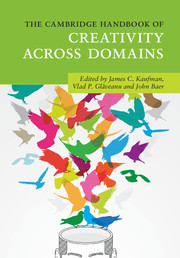Book contents
- The Cambridge Handbook of Creativity Across Domains
- The Cambridge Handbook of Creativity Across Domains
- Copyright page
- Dedication
- Contents
- Figures
- Tables
- Contributors
- Acknowledgments
- Part I Creativity and Domain
- 1 Creativity Across Different Domains
- 2 The Amusement Park Theoretical Model of Creativity
- 3 Mix and Match
- 4 Domain-General Creativity
- Part II Creativity in the Traditional Arts
- Part III Creativity in the Sciences
- Part IV Creativity in Business
- Part V Newer Domains for Creativity Research
- Part VI Creativity in Everyday Life
- Part VII Conclusion
- Index
- References
2 - The Amusement Park Theoretical Model of Creativity
An Attempt to Bridge the Domain-Specificity/Generality Gap
from Part I - Creativity and Domain
Published online by Cambridge University Press: 15 September 2017
- The Cambridge Handbook of Creativity Across Domains
- The Cambridge Handbook of Creativity Across Domains
- Copyright page
- Dedication
- Contents
- Figures
- Tables
- Contributors
- Acknowledgments
- Part I Creativity and Domain
- 1 Creativity Across Different Domains
- 2 The Amusement Park Theoretical Model of Creativity
- 3 Mix and Match
- 4 Domain-General Creativity
- Part II Creativity in the Traditional Arts
- Part III Creativity in the Sciences
- Part IV Creativity in Business
- Part V Newer Domains for Creativity Research
- Part VI Creativity in Everyday Life
- Part VII Conclusion
- Index
- References
Summary
The Amusement Park Theoretical (APT) Model of Creativity weaves together both domain-general and domain-specific factors supporting creative performance with a hierarchical structure. There are four levels of the model – Initial Requirements, General Thematic Areas, Domains, and Microdomains – that describe increasing levels of domain specificity. The APT Model reminds creativity researchers and theorists of the need to consider and to identify the differing degrees of domain generality and domain specificity in the constructs they are investigating. The APT Model also provides a useful and flexible framework for such discussions.
- Type
- Chapter
- Information
- The Cambridge Handbook of Creativity across Domains , pp. 8 - 17Publisher: Cambridge University PressPrint publication year: 2017
References
- 25
- Cited by



